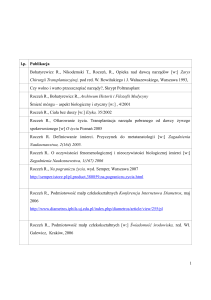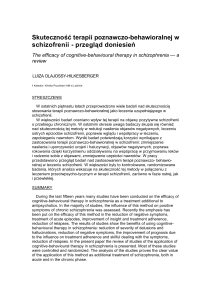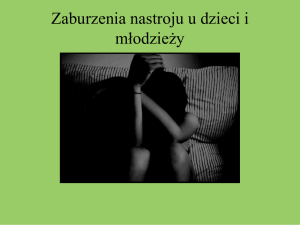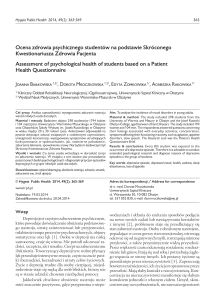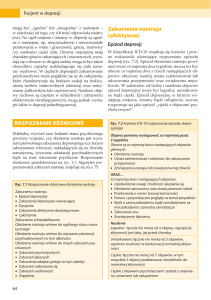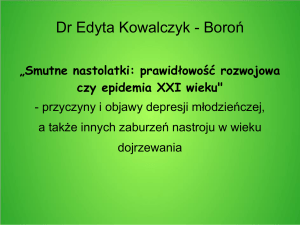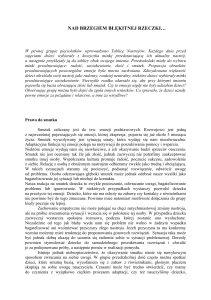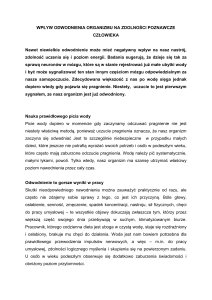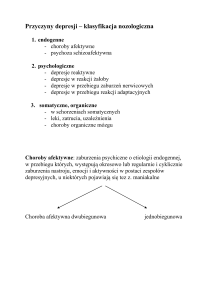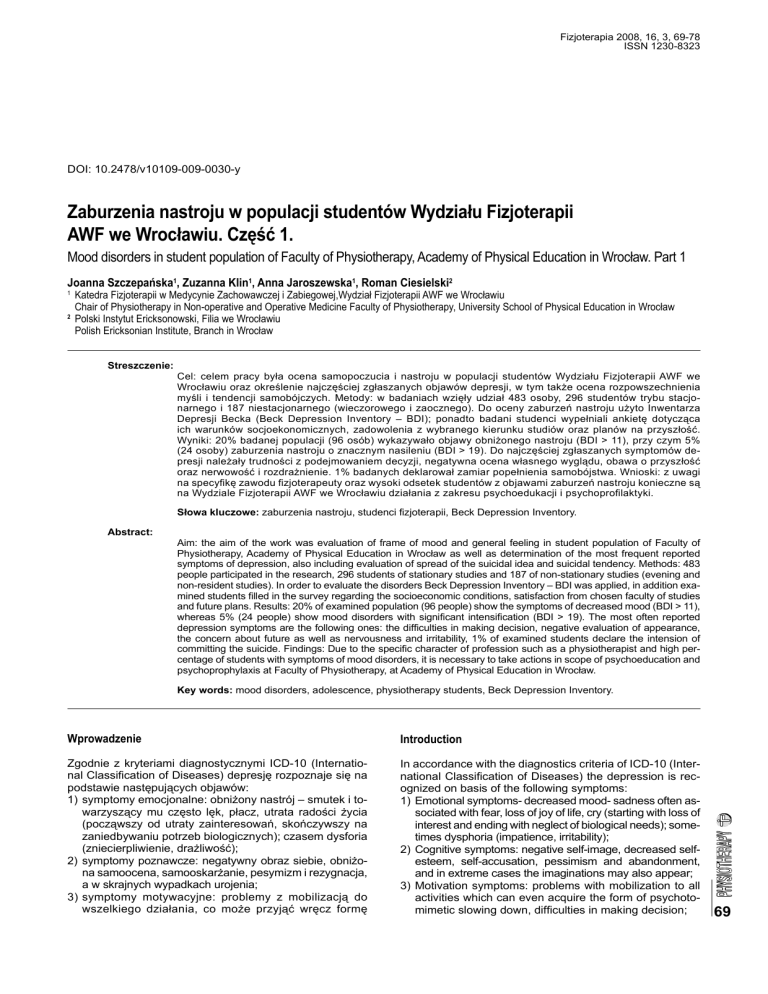
Fizjoterapia 2008, 16, 3, 69-78
ISSN 1230-8323
DOI: 10.2478/v10109-009-0030-y
Zaburzenia nastroju w populacji studentów Wydziału Fizjoterapii
AWF we Wrocławiu. Część 1.
Mood disorders in student population of Faculty of Physiotherapy, Academy of Physical Education in Wrocław. Part 1
Joanna Szczepańska1, Zuzanna Klin1, Anna Jaroszewska1, Roman Ciesielski2
1
2
Katedra Fizjoterapii w Medycynie Zachowawczej i Zabiegowej,Wydział Fizjoterapii AWF we Wrocławiu
Chair of Physiotherapy in Non-operative and Operative Medicine Faculty of Physiotherapy, University School of Physical Education in Wrocław
Polski Instytut Ericksonowski, Filia we Wrocławiu
Polish Ericksonian Institute, Branch in Wrocław
Streszczenie:
Cel: celem pracy była ocena samopoczucia i nastroju w populacji studentów Wydziału Fizjoterapii AWF we
Wrocławiu oraz określenie najczęściej zgłaszanych objawów depresji, w tym także ocena rozpowszechnienia
myśli i tendencji samobójczych. Metody: w badaniach wzięły udział 483 osoby, 296 studentów trybu stacjonarnego i 187 niestacjonarnego (wieczorowego i zaocznego). Do oceny zaburzeń nastroju użyto Inwentarza
Depresji Becka (Beck Depression Inventory – BDI); ponadto badani studenci wypełniali ankietę dotycząca
ich warunków socjoekonomicznych, zadowolenia z wybranego kierunku studiów oraz planów na przyszłość.
Wyniki: 20% badanej populacji (96 osób) wykazywało objawy obniżonego nastroju (BDI > 11), przy czym 5%
(24 osoby) zaburzenia nastroju o znacznym nasileniu (BDI > 19). Do najczęściej zgłaszanych symptomów depresji należały trudności z podejmowaniem decyzji, negatywna ocena własnego wyglądu, obawa o przyszłość
oraz nerwowość i rozdrażnienie. 1% badanych deklarował zamiar popełnienia samobójstwa. Wnioski: z uwagi
na specyfikę zawodu fizjoterapeuty oraz wysoki odsetek studentów z objawami zaburzeń nastroju konieczne są
na Wydziale Fizjoterapii AWF we Wrocławiu działania z zakresu psychoedukacji i psychoprofilaktyki.
Słowa kluczowe: zaburzenia nastroju, studenci fizjoterapii, Beck Depression Inventory.
Abstract:
Aim: the aim of the work was evaluation of frame of mood and general feeling in student population of Faculty of
Physiotherapy, Academy of Physical Education in Wrocław as well as determination of the most frequent reported
symptoms of depression, also including evaluation of spread of the suicidal idea and suicidal tendency. Methods: 483
people participated in the research, 296 students of stationary studies and 187 of non-stationary studies (evening and
non-resident studies). In order to evaluate the disorders Beck Depression Inventory – BDI was applied, in addition examined students filled in the survey regarding the socioeconomic conditions, satisfaction from chosen faculty of studies
and future plans. Results: 20% of examined population (96 people) show the symptoms of decreased mood (BDI > 11),
whereas 5% (24 people) show mood disorders with significant intensification (BDI > 19). The most often reported
depression symptoms are the following ones: the difficulties in making decision, negative evaluation of appearance,
the concern about future as well as nervousness and irritability, 1% of examined students declare the intension of
committing the suicide. Findings: Due to the specific character of profession such as a physiotherapist and high percentage of students with symptoms of mood disorders, it is necessary to take actions in scope of psychoeducation and
psychoprophylaxis at Faculty of Physiotherapy, at Academy of Physical Education in Wrocław.
Key words: mood disorders, adolescence, physiotherapy students, Beck Depression Inventory.
Wprowadzenie
Introduction
Zgodnie z kryteriami diagnostycznymi ICD-10 (International Classification of Diseases) depresję rozpoznaje się na
podstawie następujących objawów:
1) symptomy emocjonalne: obniżony nastrój – smutek i towarzyszący mu często lęk, płacz, utrata radości życia
(począwszy od utraty zainteresowań, skończywszy na
zaniedbywaniu potrzeb biologicznych); czasem dysforia
(zniecierpliwienie, drażliwość);
2) symptomy poznawcze: negatywny obraz siebie, obniżona samoocena, samooskarżanie, pesymizm i rezygnacja,
a w skrajnych wypadkach urojenia;
3) symptomy motywacyjne: problemy z mobilizacją do
wszelkiego działania, co może przyjąć wręcz formę
In accordance with the diagnostics criteria of ICD-10 (International Classification of Diseases) the depression is recognized on basis of the following symptoms:
1) Emotional symptoms- decreased mood- sadness often associated with fear, loss of joy of life, cry (starting with loss of
interest and ending with neglect of biological needs); sometimes dysphoria (impatience, irritability);
2) Cognitive symptoms: negative self-image, decreased selfesteem, self-accusation, pessimism and abandonment,
and in extreme cases the imaginations may also appear;
3) Motivation symptoms: problems with mobilization to all
activities which can even acquire the form of psychotomimetic slowing down, difficulties in making decision;
69
Joanna Szczepańska, Zuzanna Klin, Anna Jaroszewska, Roman Ciesielski
Zaburzenia nastroju w populacji studentów Wydziału Fizjoterapii AWF we Wrocławiu. Część 1.
70
Fizjoterapia 2008, 16, 3
spowolnienia psychoruchowego, trudności z podejmowaniem decyzji;
4) symptomy somatyczne: zaburzenie rytmu dobowego
(m.in. zaburzenia rytmu snu i czuwania), utrata apetytu
(ale w depresji atypowej czasem obserwuje się wzrost,
a nie spadek wagi ciała chorego), osłabienie i zmęczenie, brak zainteresowania seksem, czasem skargi na
bóle i złe samopoczucie fizyczne.
Trudno sobie wyobrazić, by osoba cierpiąca na depresję mogła skutecznie wykonywać jakikolwiek zawód
mieszczący się w tzw. sektorze pomagania (lekarz, pielęgniarka, psycholog, pedagog, również fizjoterapeuta).
Wydaje się, że spośród wymienionych profesji przede
wszystkim psycholodzy, a bardziej psychoterapeuci, są
świadomi faktu, że bez względu na kompetencje zawodowe kondycja psychiczna samego terapeuty silnie wpływa
na przebieg pracy z pacjentem i jest ważnym elementem
warunkującym powodzenie tego procesu. W codziennej
pracy z osobami niepełnosprawnymi fizjoterapeuta spędza ze swoim podopiecznym każdorazowo ok. 40-60 min.
W tym czasie motywuje pacjenta do podejmowania coraz większego wysiłku, niekiedy wiąże się to z bólem lub
wymaga pokonania własnych słabości, np. lęku przed
upadkiem. W większości przypadków pacjenci, szczególnie ci poddani długoterminowej hospitalizacji, odizolowani od domu i bliskich, wymagają wsparcia i pomocy,
a pozytywna relacja z fizjoterapeutą jest filarem procesu
rehabilitacji. Jednak trudno oczekiwać wsparcia, pomocy
i empatii od osoby, która sama boryka się kłopotami emocjonalnymi. Jeśli fizjoterapeuta jest smutny i apatyczny
lub też drażliwy i brakuje mu cierpliwości, a na domiar
złego ma problemy z mobilizacją do działania i nie wierzy,
że jego wysiłki przyniosą pozytywne efekty, to szansa na
powodzenie procesu rehabilitacji jest nikła. Dlatego celem pracy jest ocena samopoczucia i nastroju w populacji
studentów Wydziału Fizjoterapii AWF we Wrocławiu oraz
identyfikacja najczęściej zgłaszanych objawów depresji.
4) Somatic symptoms: disregulation of daily rhythm (among
others, the disregulation of sleep and vigil), loss of appetite
(but in atypical depression, the gain of weight is sometimes
observed, not the loss of patient body weight), weakening
and tiredness, loss of interest in sex, sometimes the complaints about pains and bad physical condition.
It seems to be difficult to imagine the situation that the
person who suffers from depression is able to perform any
job which is included in the group of professions providing assistance and help (a doctor, a nurse, a psychologist,
a pedagogue and also a physiotherapist). It seems that from
mentioned above professions, above all, the psychologists
and even more the physiotherapists are aware of the fact
that regardless of professional competence, the psychical
condition of the therapist himself significantly influences on
the course of work with patient and it is important element
conditioning the success of the process. At everyday work
with handicapped people, the physiotherapist spends with
his/her patient once in a time approximately 40-60 minutes.
During that time the physiotherapist motivates the patient
to make bigger and bigger effort, at times it is connected
with pain or requires overcoming their own weaknesses
e.g. fear of falling down. In most cases, the patients, in particular those who need long term hospitalization, separated
from home and close relatives, they require support and
assistance and a positive relation with physiotherapist is
the pier of the rehabilitation treatment.
However it is difficult to expect support, assistance and
empathy from a person who also struggles with emotional
troubles. If the physiotherapist is upset and apathic or also
irritable and He/she suffers from lack of patience and to
make things worse He/she Has problems with mobilization
to activities and does not believe that his/her efforts can
bring positive results then the chance of success of rehabilitation treatment is slender. That is why the aim of this
work is evaluation of general feeling and mood in students
population of Faculty of Physiotherapy, Academy of Physical Education (AWF) in Wrocław as well as identification of
most often reported depression symptoms.
Metody badań
Methods
Badaniami objęto 483 osoby. Byli to studenci I-IV roku
studiów dziennych oraz III roku wieczorowych studiów
licencjackich, II roku wieczorowych uzupełniających studiów magisterskich (w tabelach i rycinach, dla większej
przejrzystości, rocznik ten opisano jako „V rok studiów
wieczorowych”) oraz IV i V roku studiów zaocznych
Wydziału Fizjoterapii AWF we Wrocławiu. Szczegółowe
dane na temat ankietowanych respondentów zawiera
tab. 1. Badania przeprowadzono w marcu 2007 roku (rok
akademicki 2006/2007). Do pomiaru nasilenia zaburzeń
nastroju wykorzystano Inwentarz Depresji Becka (BDI)
[1]. Inwentarz składa się z 21 pytań opisujących za pomocą 4 twierdzeń symptomy depresji (emocjonalne, poznawcze, motywacyjne i fizyczne). Natężenie każdego
z symptomów depresji oceniane jest wg czterostopniowej skali (0-1-2-3). Uzyskane wyniki sumuje się; im wyższy wynik, tym większe nasilenie objawów depresyjnych
(wyniki zamykają się w przedziale od 1 do 63 punktów).
Wynik 0-11 oznacza brak zaburzeń nastroju, 12-19 obniżony nastrój i złe samopoczucie, powyżej 19 – objawy
depresji o znacznym nasileniu. BDI jest powszechnie
używanym, trafnym i rzetelnym narzędziem wykrywającym zaburzenia depresyjne. Należy jednak pamiętać,
że uzyskane wyniki mają charakter przesiewowy i nie są
jednoznaczne z postawieniem diagnozy klinicznej precyzującej typ zaburzeń depresyjnych. Ponadto badane
osoby wypełniały opracowaną na potrzeby projektu an-
483 people participated in the research. They were the students of I-IV year of stationary studies and III year of BA
evening studies, II year of evening complementary master
studies (in tables and graphs for better transparency, that
year of studies was described as „V year of evening studies”) as well as IV and V year of non-resident studies of
Faculty of Physiotherapy AWF in Wrocław. Detailed data on
subject of surveyed respondents can be found in (Table 1).
The research was conducted in March 2007 (academic
year 2006/2007). In order to measure the intensification of
mood disorders BDI was applied [1]. The inventory consists of 21 questions describing with use of 4 statements,
the depression symptoms (emotional, cognitive, motivation and physical). The intensification of each of symptoms is evaluated according to 4-degree scale (0-1-2-3).
The obtained results sum up, the higher result the bigger intensification of depression symptoms (the possible
results are within the scope from 1 to 63 points). Result
0-11 means that there is Lack of mood disorders, 12-19
decreased mood and Bad feeling, more than 19 – depression symptoms with significant intensification. BDI is widely
used tool which is accurate and reliable while recognizing
depression diregulations. However, it should be in mind
that the results have culture (inoculation) character and are
not unequivocal with clinical diagnosis specifying the type
of depression disorders. In addition examined people filled
in, elaborated and prepared for a need of the research, the
Physiotheraphy 2008, 16, 3
Joanna Szczepańska, Zuzanna Klin, Anna Jaroszewska, Roman Ciesielski
Mood disorders in student population of Faculty of Physiotherapy, Academy of Physical Education in Wrocław. Part 1
kietę dotyczącą warunków socjoekonomicznych, zadowolenia z wybranego kierunku studiów oraz planów na
przyszłość. Zarówno Inwentarz Depresji Becka, jak i opisaną wyżej ankietę respondenci wypełniali anonimowo.
survey regarding the socioeconomic conditions, satisfaction from chosen faculty of studies and future plans. Both
Beck Depression Inventory and described above survey
had a anonymous character for the respondents.
Wyniki
Results
Szczegółowe wyniki nasilenia zaburzeń afektywnych w omawianej populacji zawierają tab. 1 oraz ryc. 1. Analiza zebranego materiału sugeruje, że wśród studentów Wydziału Fizjoterapii AWF we Wrocławiu problem zaburzeń nastroju jest
zjawiskiem poważnym. W badanej próbie (n = 483) ok. 20%
studentów zgłasza objawy obniżonego nastroju i złego samopoczucia psychicznego (n = 96), przy tym ok. 5% badanej
populacji cierpi na zaburzenia nastroju o poważnym nasileniu
(BDI > 19). Ustalono, że najmniejszy odsetek osób z objawami obniżonego nastroju obserwuje się na I roku studiów
dziennych (15%), a największy na II roku wieczorowych uzupełniających studiów magisterskich 28% („V rok studiów wieczorowych”).
W ramach analizy jakościowej zebranego materiału
w tab. 3 stwierdzono, że w grupie osób z zaburzeniami nastroju najczęściej zgłaszano następujące objawy:
trudności z podejmowaniem decyzji, negatywna ocena
własnego wyglądu, obawa o przyszłość, nerwowość,
rozdrażnienie, zmiany masy ciała, samooskarżanie, poczucie smutku i przygnębienia, trudności z motywacją,
obawa o swoje zdrowie, uczucie ciągłego zmęczenia. Do
najrzadziej zgłaszanych objawów należały myśli samobójcze. 60% badanych deklaruje, że w razie problemów
osobistych skorzysta z pomocy specjalisty (np. psychologa).
Detailed results of intensification of affective disregulation
in discussed population contain (are presented) in (Table
1 and Fig. 1). The analysis of gathered material suggests
that among students of Faculty of Physiotherapy AWF in
Wrocław the problem of mood disorders is a serious phenomenon. In examined sample (n = 483) about 20% of
students reports the symptoms of decreased mood and
bad psychical feeling (n = 96), while about 5% of examined
population suffer from mood disorders with a significant
intensification (BDI > 19). It was assigned that the smallest percentage of people with decreased mood symptoms
can be observed among students of I year of stationary
studies (15%), and the highest among students of II year
of evening complementary master studies 28% („V year of
evening studies”) .
Within a qualitative analysis of collected material (Table
3) it was claimed that in group of people with mood disorders, the following symptoms were most often reported: difficulties in ma king decision, negative self-image, concern
about future, nervousness and irritation, chances in body
weight (mass), feeling of sadness and depression, self-accusation, difficulties with motivation, concern about health,
permanent feeling of tiredness. The most rarely reported
symptoms are suicidal thoughts. 60% of examined people
declare that in case of personal problems will use help of
an specialist (e.g. psychologists).
Dyskusja
Discussion
W latach 1988-1995 na zlecenie Światowej Organizacji
Zdrowia (WHO) przeprowadzono międzynarodowe, wieloośrodkowe badania dotyczące problemów psychicznych
i psychiatrycznych wśród pacjentów podstawowej opieki
zdrowotnej. Ustalono, iż depresja występuje u 12,5% badanych pacjentów i należy do najczęściej spotykanych zaburzeń psychicznych badanej populacji [2]. W 2000 r. ta
sama organizacja uznała depresję za czwartą, najgroźniejszą, chorobę świata, biorąc pod uwagę koszty bezpośrednie (opieka medyczna, terapia, hospitalizacja), ale przede
wszystkim koszty pośrednie (niezdolność do prawidłowego pełnienia ról zawodowych i rodzinnych, szeroko pojęte
koszty społeczne). WHO przewiduje, że w 2020 r. depresja
zajmie już drugie miejsce na liście najpoważniejszych chorób świata.
Z uwagi na rozpowszechnienie zaburzeń afektywnych
w populacji ogólnej oraz na rangę problemu badania samopoczucia i nastroju prowadzone są także w środowiskach
akademickich. W Polsce są to ciągle doniesienia jednostkowe, brakuje badań zakrojonych na szeroką skalę, niemniej
jednak analiza dostępnego piśmiennictwa polskiego wskazuje, że z roku na rok wzrasta odsetek osób z zaburzeniami
nastroju. W latach 1979-1982 depresje i kryzysy psychiczne
były zjawiskiem bardzo rzadkim wśród młodzieży akademickiej [3], ale już w latach 1990-1991 w badaniach przeprowadzonych na uczelniach łódzkich w grupie 2357 studentów (politechniki, uniwersytetu, akademii medycznej oraz
wyższych szkół artystycznych) stwierdzono występowanie
depresji u 15,5% studentów uczelni artystycznych i ok. 6%
studentów Łódzkiej Akademii Medycznej [4]; najmniejszy
In years 1988-1995, due to order of World Health Organization (WHO) the international, multicentre research was conducted regarding psychical problems and psychiatric among
patients of foundation health care. Within the framework of
that research was assigned that depression is present in
12.5% of examined patients and belongs to the most often
met psychical diregulations in examined population [2]. In
year 2000 the same organization recognized depression as
the fourth, the most dangerous Word disease, taking into
consideration direct costs (medical care, therapy, hospitalization) and above all indirect costs (inability to perform Professional and family roles, widely understood social costs).
WHO predicts that in year 2020 depression will be placed
on the second position on the list of the most serious Word
illnesses.
Due to the fact of spreading affective diregulations in
general population and rang of the problem, mood and
general feeling examination are run also in academic environment. In Poland they are still single reports. There
is lack of research which would have character of wide
scale, however, the analysis of available Polish publications shows that year after year the percentage of people
with moos disorders is increasing. In years 1979-1982 depression and psychical crisis were very rare phenomenon
among academic youth [3], but already in years 1990-1991 in research conducted at Łódź universities, in group
of 2357 students of University of Technology, University,
Medical Academy and Higher Artistic School found the
presence of depression in 15.5% of students of artistic
schools and about 6% students of Łódz Medical Acad-
71
Joanna Szczepańska, Zuzanna Klin, Anna Jaroszewska, Roman Ciesielski
Zaburzenia nastroju w populacji studentów Wydziału Fizjoterapii AWF we Wrocławiu. Część 1.
72
odsetek osób z zaburzeniami nastroju obserwowano wtedy
wśród studentów politechniki. W 2004 roku ponownie badano studentów uczelni łódzkich (n = 263) w wieku 19-25 lat;
tym razem objawy depresji stwierdzono u 22% respondentów, najwyższy odsetek na II roku studiów medycznych, bo
aż 29% [5]. Niestety, wyników tych nie można porównywać
wprost, ponieważ użyte zostały odmienne narzędzia badawcze, niemniej jednak wydaje się, że problem ten narasta.
W tym samym roku podobne badania prowadzono w Krakowie na łącznej grupie 450 słuchaczy Uniwersytetu Jagiellońskiego, Akademii Pedagogicznej i Politechniki Krakowskiej.
Tam depresje i kryzysy psychiczne stwierdzono u 21,6%
respondentów (odpowiednio 19,3%, 22,0%, 24,4%). Tym
razem największy odsetek osób z objawami obniżonego
nastroju obserwowano na politechnice [3]. Kolejne doniesienia pochodzą z 2005 r. z Akademii Medycznej w Gdańsku,
gdzie badano rozpowszechnienie objawów depresyjnych
i lękowych. Ankietowano 206 studentów I i IV roku Wydziału
Lekarskiego. Ustalono, że proporcjonalnie najwięcej osób
z objawami obniżonego nastroju jest na IV roku (18,4%).
W badanej populacji aż 41,2% ankietowanych zgłaszało objawy związane z przeżywanym lękiem.
Pomimo iż bezpośrednie porównywanie cytowanych doniesień nie jest możliwe z uwagi na stosowanie przez poszczególnych autorów odmiennych narzędzi badawczych,
wydaje się, że począwszy od lat 90. obserwuje się wśród
młodzieży akademickiej stały, wysoki odsetek osób z zaburzeniami nastroju (od kilkunastu aż do niespełna 30%
w zależności od kierunku i roku studiów). Przy tym trudno
ustalić jakieś stałe tendencje świadczące o tym, że na wybranych uczelniach, czy też kierunkach, odsetek ten jest
wyraźnie większy w porównaniu z innym. Wyniki uzyskane
w 2007 roku na Wydziale Fizjoterapii AWF we Wrocławiu
najlepiej porównać z doniesieniami Adamiak i in. (2004)
z uwagi na dobór narzędzi badawczych; w obu przypadkach był to Inwentarz Depresji Becka (BDI) oraz podobna
liczba ankietowanych osób (483 vs. 472). Autorzy cytowanego doniesienia porównywali nasilenie objawów depresji
wśród studentów II (n = 177) i VI (n = 86) roku Akademii
Medycznej w Łodzi z grupą kontrolną (n = 109) studentów
innych uczelni (Politechnika Łódzka, Uniwersytet Łódzki).
Ustalono, że w całej badanej populacji było 22,0% osób
z objawami obniżonego nastroju [5]. Wyniki uzyskane
w 2007 roku wśród studentów Wydziału Fizjoterapii są bardzo podobne, w sumie u 20% respondentów stwierdzono
objawy depresji.
Jeśli chodzi o różnice pomiędzy poszczególnymi latami studiów, to autorzy badań łódzkich prowadzonych
na Akademii Medycznej raportowali wyraźną tendencję
spadkową w trakcie trwania studiów. Na II roku obniżony nastrój stwierdzono u 29% ankietowanych, a na VI już
tylko u 14% studentów tego rocznika. Badacze uznali, że
na końcowych latach studiów młodzież wykazuje większą
dojrzałość emocjonalną, lepiej radzi sobie z sytuacjami
trudnymi (np. zaliczenia, egzaminy czy też samodzielna
egzystencja) charakterystycznymi dla życia studenckiego [5]. Doniesienia z Akademii Medycznej w Gdańsku
częściowo także potwierdzają tę tezę, choć nie wykazano
istotnych statystycznie różnic pomiędzy rokiem I i IV, jeśli
chodzi o poziom depresji, to jednak istotnie zmalał poziom lęku na IV roku w stosunku do roku II (p < 0,05) [6].
Oczywiście depresja i lęk to dwie różne cechy, niemniej
jednak w pewnym zakresie powiązane ze sobą, ponadto
obie są ważnym wskaźnikiem kondycji psychicznej badanej populacji. Wydaje się zatem, że w przypadku studiów
medycznych czynnik czasu oraz poziom zaawansowania
edukacji mogą mieć znaczenie, jeśli chodzi o nasilenie
zaburzeń nastroju. W początkowych latach jest ono istotnie wyższe (na II roku AM w Łodzi nawet 29% osób z objawami depresji), z czasem jednak maleje. W przypadku
Fizjoterapia 2008, 16, 3
emy [4], the smallest percentage of people with mood deregulation was observed among students of University of
Technology. In year 2004 the students of Łódź universities
were examined (n = 263) at the age of 19-25, and then
the depression symptoms were observed in total of 22%
of respondents, the highest percentage among student of
II year of medical studies, right up to 29% [5]. Unfortunately the results cannot be directly compared because
different research tools were applied, however it seems
that the problem is accumulating. In the same year similar research was conducted in Cracow, in Total group of
450 students of Jagiellonian University in Krakow, Academy of Pedagogy and Krakow University of Technology,
then depression and psychical crisis were observed in
21.6% of respondents (relatively 19.3%, 22.0%, 24.4%).
At the same time the highest percentage of people with
decreased mood symptoms was observed at University
of Technology [3]. Further reports come from year 2005
from Medical Academy in Gdańsk, where spreading of
depression and fear symptoms were examined. 206 students were polled, I and IV year of Faculty of Medicine. It
was agreed that proportionally the most people with decreased mood symptoms are found among students of
IV year (18.4%). Significantly bigger was spreading the
complaints connected with experienced fear, in examined
population, right up to 41.2% of surveyed people reported
those symptoms.
Despite the fact that direct comparison quoted reports
is not possible, due to application of different research
tools by the particular authors, it seems that beginning
from 90s, high percentage of people with mood disorders
among academic youth can be observed (from several
right up to 30% in dependence on faculty and year of
studies). However, it is difficult to determine some constant tendencies giving evidence that at particular universities or the faculties the percentage is clearly higher
in comparison to other ones. Results obtained in year
2007 at Faculty of Physiotherapy of AWF, in Wrocław can
be compared in the Best way with reports of Adamiak et
al. (2004) due to the fact that selection of research tools
in both cases was Beck Depression Inventory (BDI) as
well as similar number of surveyed people (483 vs 472).
The authors of quoted reports compared the intensification of depression symptoms among students of II
(n = 177) and VI (n = 86) year of Medical Academy in
Łódź with control group (n = 109) of students of other
universities (Lódź Uviversity of Technology, Łódź University). It was agreed that in the whole examined population there were about 22.0% people with decreased
mood symptoms [5]. Results obtained in year 2007
among students of Faculty of Physiotherapy are very
similar, in total in 20% of respondents depression symptoms were observed.
As far as the difference between particular years of
studies is concerned, the authors of Lódź research conducted at Medical Academy were reporting the distinct
dropping tendency during lasting the studies. At II year
the decreased mood as observed in 29% of surveyed,
whereas at VI only in 14% students of this year. The researches claimed that at the final years of studies, the
youth show bigger emotional maturity, cope in a better
way with difficult situation (e.g. credits, exams or also independent existence) characteristic of students life [5].
Reports from Medical Academy in Gdansk partly also
confirm this thesis, however, the statistically significant
differences between I and IV year were not observed,
as the level of depression is concerned, the level of fear
decreased Ina significant way at IV year in relation to
II year (p < 0.05) [6]. It is obvious that depression and fear
are two different features, however, in some scope they
Physiotheraphy 2008, 16, 3
Joanna Szczepańska, Zuzanna Klin, Anna Jaroszewska, Roman Ciesielski
Mood disorders in student population of Faculty of Physiotherapy, Academy of Physical Education in Wrocław. Part 1
studentów Wydziału Fizjoterapii AWF we Wrocławiu nie
można dopatrzyć się podobnej tendencji (tab. 1, ryc. 1).
Najmniejszy odsetek osób z objawami obniżonego nastroju obserwuje się na I roku (15%), a następnie 21%,
17%, 21% na kolejnych latach studiów dziennych. Spośród całej badanej próby (studia dzienne, wieczorowe, zaoczne) zdecydowanie największa grupa osób z objawami
depresji rekrutuje się z II roku wieczorowych, uzupełnia-
are associated with each other, moreover both features
are significant indicator of psychical condition of examined population. It seems that in case of medical studies
the time factor and level of education advancement may
have meaning, as the intensification of mood disorders
is concerned in beginning years is significantly higher (at
II year of Medical Academy in Lódź even 29% of people
with depression symptoms), along the time it is decreas-
Tabela 1. Charakterystyka grupy badanej oraz wyniki badań nastroju i samopoczucia (n = 483)
Table 1. Characteristic of examined group and result of mood and general feeling examination (n = 483)
Rok studiów
Year of studies
Ogółem
Total
I rok
dzienne
I year
stationary
II rok
dzienne
II year
stationary
III rok
dzienne
III year
stationary
IV rok
dzienne
IV year
stationary
III rok
wieczorowe
III year
evening
V rok
wieczorowe
V year
evening
IV rok
zaoczne
IV year
non-resident
V rok
zaoczne
V year
non-resident
Liczba studentów
Number of students
studiowało
studied
647 (100%)
ankietowano
surveyed
483 (75%)
studiowało
studied
84 (100%)
ankietowano
surveyed
72 (86%)
studiowało
studied
118 (100%)
ankietowano
surveyed
81 (67%)
studiowało
studied
139 (100%)
ankietowano
surveyed
63 (45%)
studiowało
studied
108 (100%)
ankietowano
surveyed
80 (74%)
studiowało
studied
25 (100%)
ankietowano
surveyed
24 (96%)
studiowało
studied
70 (100%)
ankietowano
surveyed
64 (91%)
studiowało
studied
39 (100%)
ankietowano
surveyed
38 (97%)
studiowało
studied
64 (100%)
ankietowano
surveyed
60 (94%)
BDI (Beck Depression Inventory) – Inwentarz Depresji Becka
SD – standard deviation (odchylenie standardowe)
1 – brak zaburzeń nastroju (BDI 0-11)
lack of mood disorders (BDI 0-11)
2 – objawy obniżonego nastroju i złego samopoczucia (BDI 12-19)
decreased mood symptoms and bad general feeling (BDI 12-19)
3 – nasilone objawy depresji (BDI > 19)
intensified depression symptoms (BDI > 19)
Samopoczucie i nastrój
Mood and general feeling
BDI (± SD)
1
2
3
6,9 (± 6,1)
80%
15%
5%
5,7 (± 4,4)
85%
15%
0%
7,5 (± 6,7)
79%
14%
7%
5,3 (± 5,4)
83%
16%
1%
7,6 (± 7,5)
79%
12%
9%
6,2 (± 4,4)
84%
16%
0%
7,9 (± 6,6)
72%
19%
9%
7,0 (± 6,6)
82%
13%
5%
7,2 (± 5,0)
82%
16%
2%
73
Joanna Szczepańska, Zuzanna Klin, Anna Jaroszewska, Roman Ciesielski
Zaburzenia nastroju w populacji studentów Wydziału Fizjoterapii AWF we Wrocławiu. Część 1.
Fizjoterapia 2008, 16, 3
100%
80%
60%
80%
85%
79%
83%
79%
72%
84%
82%
82%
18%
18%
8
9
40%
20%
20%
21%
15%
28%
21%
17%
16%
0%
1
2
nasilone objawy depresji (BDI>19)
3
nasilone
objawy depresji (BDI>19)
intensified depression symptoms (BDI>19)
1 – cała badana grupa (n = 483)
the entire group (n = 483)
2 – I rok studiów dziennych
I year of stationary studies
3 – II rok studiów dziennych
II year of stationary studies
4
5
6
obniżony nastrój (BDI>11)
obniĪony
nastrój (BDI>11)
mood depression (BDI>11)
7
brak zaburzeń nastroju (BDI 0-11)
no mood disorders (BDI 0-11)
brak zaburzeĔ nastroju (BDI 0-11)
4 – III rok studiów dziennych
III year of stationary studies
5 – IV rok studiów dziennych
IV year of stationary studies
6 – III rok studiów wieczorowych
III year of evening studies
7 – V rok studiów wieczorowych
V year of evening studies
8 – IV rok studiów zaocznych
IV year of non-resident studies
9 – V rok studiów zaocznych
V year of non-resident studies
Ryc. 1. Procentowy rozkład zaburzeń nastroju na poszczególnych latach studiów w badanej populacji
Fig. 1. Percentage distribution of mood disregulations at particular years of studies in examined population
74
jących studiów magisterskich – 28% (w tab. „V rok studiów wieczorowych”), a więc osób kończących edukację
na uczelni. Niemniej jednak większą i bardziej rzetelną
wiedzę na ten temat przyniosą planowane w przyszłości,
dalsze badania samopoczucia i nastroju na Wydziale Fizjoterapii, dzięki którym będzie można porównać wyniki
tej samej grupy osób na kolejnych latach studiów i obserwować zmiany. Tendencja obserwowana w przypadku studentów medycyny (spadek odsetka osób z depresją na wyższych rocznikach) nie uzyskuje potwierdzenia
w populacji studentów Wydziału Fizjoterapii.
Dla uzupełnienia danych ilościowych przeprowadzono także jakościową analizę najczęściej zgłaszanych
objawów obniżonego nastroju w grupie osób z BDI > 11
(n = 96). W tym ujęciu na pierwszy plan wysuwają się:
trudności studentów z podejmowaniem decyzji, negatywna ocena własnego wyglądu, obawa o przyszłość oraz
nerwowość i rozdrażnienie; w dalszej kolejności – zmiany
masy ciała, obwinianie siebie, poczucie smutku i przygnębienia, trudności z motywacją, obawa o swoje zdrowie
i uczucie ciągłego zmęczenia (tab. 2). Dane raportowane przez innych autorów w dużej mierze pokrywają się
z wynikami uzyskanymi przez nasz zespół. Gruszczyński
jako najczęściej zgłaszane objawy wymienia: wyczerpanie psychofizyczne, obniżony nastrój, zaburzenia snu
i stany lękowe [4]. Kowalewski – zwiększoną drażliwość
oraz napięcie psychiczne [3], Marek – nasilony lęk [6].
Często wymieniane przez innych autorów stany lękowe
w naszych badaniach mogą manifestować się w postaci
obawy o przyszłość czy też własne zdrowie. W tym miejscu warto podkreślić, że spośród wszystkich wymienianych objawów najrzadziej w populacji studentów AWF
wymieniane były myśli samobójcze (1% ankietowanych
osób deklarował jednoznacznie zamiar popełnienia samobójstwa. W badaniach Kowalewskiego wskaźnik ten
ing. In case of students of Faculty of Physiotherapy AWF,
in Wrocław the similar tendency cannot be observed.
(Table 1, Fig. 1). The smallest percentage of people with
decreased mood symptoms can be observed at I year
(15%), and then 21%, 17%, 21% at the following years
of daily studies. Of entire examined group (stationary
studies, evening studies, non-resident studies) definitely
the biggest group of people with depression symptoms
is recruited from the second year of evening studies of
complementary master studies 28% in table: („V year of
evening studies), so among people who are graduating
from the studies. However, wider and more reliable knowledge on this subject will bring planned in future, further
research of mood and general feeling at Faculty of Physiotherapy, thanks to them it will be possible to compare
the results of the same group of people at the following
years of studies and observe the changes occurring during the period of time. Nowadays, the tendency observed
in case of students of medicine (decrease percentage of
students with depression at higher years) does not find
the confirmation among student population of Faculty of
Physiotherapy.
In order to complete quantitative data, the qualitative
analysis was also conducted of the most often reported
decreased mood syndromes in group of people with BDI
> 11 (n = 96). Regarding to that grasp at the foreground
are: the difficulties of students in making decision, negative self-image, concern of future, nervousness and irritability, and next change of body mass (weight), self accusation, feeling of sadness and depression, difficulties
with motivation, concern of health and feeling of permanent tiredness (Table 2). Data reported by other authors
in a significant part agree with results obtained by our
team. Gruszczyński as the most often reported symptoms lists psychophysical exhaustion, decreased mood,
Physiotheraphy 2008, 16, 3
Joanna Szczepańska, Zuzanna Klin, Anna Jaroszewska, Roman Ciesielski
Mood disorders in student population of Faculty of Physiotherapy, Academy of Physical Education in Wrocław. Part 1
Tabela 2. Objawy depresji w grupie osób, u których stwierdzono obniżony nastrój BDI > 11 (n = 96), w kolejności od najczęściej występujących
Table 2. Depression symptoms in group of people in whom the decreased mood was recognized BDI >11 (n = 96), in order of the most
often present
Inwentarz Depresji Becka (BDI) – badany objaw
Beck Deoression Inventory (BDI) – examined symptom
Suma punktów
Total points
Trudności z podejmowaniem decyzji
Difficulties in making decisions
107
Negatywna ocena własnego wyglądu
Negative evaluation of self image
102
Obawa o przyszłość
Concern about future
97
Nerwowość i rozdrażnienie
Nervousness and irratibility
94
Zmiany masy ciała
Changes of body mass (weight)
89
Samooskarżanie
Self- accusation
88
Poczucie smutku i przygnębienia
Feeling of sadness and upset
87
Trudności z motywacją
Difficulties in motivation
82
Obawa o swoje zdrowie
Concern of own health
81
Poczucie ciągłego zmęczenia
Feeling of permanent tiredness
80
Poczucie winy
The feeling of guilt
79
Brak przyjemności z wykonywania codziennych czynności
Lack of pleasure in doing daily routine
78
Oczekiwanie kary
Expecting the punishement
74
Problemy ze snem
Problems with sleep
71
Niezadowolenie z siebie
Dissatisfaction of oneself
68
Płaczliwość
Tendency of crying
65
Negatywny obraz siebie na tle innych osób
Negative self-image according to the others
61
Pogorszenie kontaktów międzyludzkich
Deterioration of interpersonal contacts
60
Utrata zainteresowań seksem
Lack of interest in sex
51
Zmiana apetytu
Change of appetite
47
Myśli samobójcze
Suicidal thougths
25
był znacznie wyższy i wynosił 2,9% na Uniwersytecie Jagiellońskim, 4,1% na Akademii Pedagogicznej i aż 6,3%
wśród studentów Politechniki Krakowskiej [3]. Ale jeśli
w naszych badaniach uwzględnić także następujące
stwierdzenie: „Myślę o samobójstwie, ale nie byłbym
w stanie go popełnić”, to odsetek osób zagrożonych tym
czynem wzrasta na Wydziale Fizjoterapii do 5,8%, co jest
już bardzo wysokim wskaźnikiem.
sleep disorders and fear states [4]. Kowalewski reports
increased irritability and psychical tension [3], Marek intensified fear [6]. Very often listed by other authors fear
states in our research can manifest as concern of future
or also the concern of own health. It is worth emphasizing that among all listed symptoms, the rarest in student
population of AWF were the suicidal thoughts (1% of
surveyed people declared in a clear way, the intension
75
Joanna Szczepańska, Zuzanna Klin, Anna Jaroszewska, Roman Ciesielski
Zaburzenia nastroju w populacji studentów Wydziału Fizjoterapii AWF we Wrocławiu. Część 1.
Fizjoterapia 2008, 16, 3
of committing the suicide). In Kowalewski’s research the
indicator was much higher and amounted to 2.9% at Jagellonian University, 4.1% at Academy of Pedagogy and
even 6,3% among students of University of Technology
in Krakow [3]. But if in our research take into consideration also the following statement: “I am considering the
suicide but I would not be able to commit it”, then the
percentage of people in danger of that act increases at
Faculty of Physiotherapy up to 5,8%, that is a very high
value of the indicator.
As the completion of obtained data thanks to applying Beck Depression Inventory (BDI) the authors of
the Project elaborated additional survey containing the
questions about socioeconomic factors connected with
mood disorders. Detailed analysis of that part of the
project will be presented in the separate article, in herein
elaboration only one out of ten questions was placed, it
was: “In case of personal problem would you use help
of psychologist?”. In examined sample 60% of students
answer „yes” and 40% „no”, Bering in mind that there
is a distinct trend. At lower years of studies (I-II year)
less than a half of examined declares that kind of need
whereas at higher years even 76% of surveyed people
claim that in case of appearing of problems would use
the help of the psychologist (Fig. 2). It is good information because the fundamental problem in treatment and
therapy of mood disorders is that patients very often do
not look for a specialist help at all (psychologist, psychiatrist, psychotherapist), that is why in publications often
the fact is mentioned that data regarding the presence
of depression in general population is still underestimated. It is worth naming the information Publisher in 2005,
coming from Medical Academy in Gdańsk, where among
people who have chosen a doctor profession more than
Jako uzupełnienie danych uzyskanych dzięki zastosowaniu Inwentarza Depresji Becka (BDI) autorzy projektu
opracowali dodatkowo ankietę zawierającą pytania o czynniki socjoekonomiczne związane z zaburzeniami nastroju.
Szczegółowa analiza tej części projektu zostanie przedstawiona w odrębnym artykule; w niniejszym opracowaniu zamieszczono jedynie jedno spośród dziesięciu dodatkowych
pytań. Brzmiało ono: „Czy w przypadku problemów osobistych skorzystałbyś/skorzystałabyś z pomocy psychologa?” W badanej próbie 60% studentów odpowiada „tak”,
a 40% „nie”, z tym że na niższych latach studiów (I-II rok)
mniej niż połowa badanych deklaruje taką potrzebę, a na
starszych rocznikach już nawet 76% ankietowanych osób
twierdzi, że w razie pojawienia się problemów skorzysta
z pomocy psychologicznej (ryc. 2). To dobra informacja,
ponieważ podstawowym problemem w leczeniu i terapii
zaburzeń nastroju jest to, że pacjenci bardzo często w ogóle nie szukają fachowej pomocy (psycholog, psychiatra,
psychoterapeuta). Dlatego w piśmiennictwie często wskazuje się fakt, że dane dotyczące występowania depresji
w ogólnej populacji są ciągle niedoszacowane. W tym miejscu warto przytoczyć informacje opublikowane w 2005 r.
pochodzące z Akademii Medycznej w Gdańsku. Spośród
osób, które wybrały zawód lekarza ponad 2/3 deklaruje, że
w przypadku rozpoznania u siebie objawów depresji nie
szukałaby pomocy u lekarza psychiatry, część respondentów udałaby się do psychologa lub lekarza rodzinnego, ale
nadal prawie 40% ankietowanych twierdzi, że w ogóle nie
szukałaby pomocy żadnego specjalisty [6].
Wydaje się, że studenci Wydziału Fizjoterapii AWF
we Wrocławiu w miarę trwania edukacji zyskują coraz
większą wiedzę na temat zaburzeń nastroju, nie chroni
to ich, niestety, przed pojawieniem się tego typu zaburzeń (u 20% badanych stwierdzono objawy depresji), ale
100%
80%
60%
40%
69%
60%
49%
20%
76%
68%
76%
65%
56%
44%
0%
1
2
3
4
5
6
7
8
9
TAK
NIE
TAK NO
NIE
YES
1 – cała badana grupa (n = 483)
the entire group (n = 483)
2 – I rok studiów dziennych
I year of stationary studies
3 – II rok studiów dziennych
II year of stationary studies
76
4 – III rok studiów dziennych
III year of stationary studies
5 – IV rok studiów dziennych
IV year of stationary studies
6 – III rok studiów wieczorowych
III year of evening studies
7 – V rok studiów wieczorowych
V year of evening studies
8 – IV rok studiów zaocznych
IV year of non-resident studies
9 – V rok studiów zaocznych
V year of non-resident studies
Ryc. 2. Procentowy rozkład odpowiedzi na pytanie „Czy w razie problemów osobistych skorzystałbyś z pomocy psychologa?”
Fig. 2. Percentage distribution of answers to the question: In case of personal problems would you use help of psychologist?”
Physiotheraphy 2008, 16, 3
Joanna Szczepańska, Zuzanna Klin, Anna Jaroszewska, Roman Ciesielski
Mood disorders in student population of Faculty of Physiotherapy, Academy of Physical Education in Wrocław. Part 1
być może w kryzysowym dla siebie momencie zdecydują się skorzystać z pomocy specjalisty. Można mieć
także nadzieję, że rehabilitant, który potrafi rozpoznać
u siebie objawy depresji i jest gotów skorzystać z tego
powodu z pomocy specjalisty, podobnie będzie postępował w przypadku swoich pacjentów, będzie bardziej wyczulony na ich kondycję psychiczną i być może będzie
potrafił zachęcić ich do podjęcia odpowiedniej terapii.
Natomiast w przypadku, gdy sam fizjoterapeuta cierpi
z powodu obniżonego nastroju, jest labilny emocjonalnie,
ma poczucie wyczerpania psychofizycznego, to z punktu
widzenia jego pacjentów sytuacja ta zmniejsza szanse
na pomyślny przebieg procesu usprawniania. Z racji wykonywanego zawodu mieszczącego się, jak wcześniej
wspomniano, w tzw. sektorze pomagania, fizjoterapeuci są zobowiązani do świadczenia opieki i pomocy oraz
budowania pozytywnych, wspierających relacji z pacjentami. Bez tego nawet dobrze wyszkolony fachowiec nie
będzie odnosił sukcesów w swoim zawodzie ani czerpał
przyjemności z jego wykonywania. Dlatego też z uwagi na wysoki odsetek osób zagrożonych rozwojem zaburzeń nastroju wśród studentów Wydziału Fizjoterapii
AWF we Wrocławiu konieczne jest propagowanie wiedzy
z zakresu zaburzeń afektywnych: rozpoznawania objawów, sposobów leczenia oraz konsekwencji zdrowotnych i społecznych nieleczonej depresji.
2/3 examined declares that in case of recognition depression regarding their own person, they would not look
for help of psychiatrist, some of respondents would go
to psychologist or family doctor but still almost 40% of
surveyed claim that they would not look for a help of
specialist at all [6].
It seems that the students of Faculty of Physiotherapy
of AWF Wrocław along lasting the education acquire the
bigger awareness of the subject of mood disorders, that
fact does not protect them against appearing that kind of
diregulations (in 20% of surveyed the depression symptoms were observed), but it is likely that in crisis moment
for them they will decide to use the specialist help. There
is also hope that the therapist who can recognize his own
depression symptoms and is ready to use help of specialist due to that cause, will proceed in a similar way according to his/her patients, will be more sensitive to their
psychical condition and maybe will be able to encourage
them to undertake the accurate therapy. However in case
when the physiotherapist himself/herself suffers from decreased mood, is changeable according to his/her mood,
has the feeling of psychophysical exhaustion then from
the point of view of his/her patients is. Due to performed
job, which is categorized, as already was mentioned, is so
called „assistance and help sector”, physiotherapists are
obliged to provide care and help as well as establishing
positive, supporting relations with patients. Without those
functions ever very well qualified specialist neither will be
successful in his/her job nor have pleasure in performing it. Due to the high percentage of people endangered
with development of mood disorders among students of
Faculty of Physiotherapy at AWF Wrocław it is necessary
to promote the knowledge in scope of affective disregulations: symptoms recognition, methods of treatment as
well as health and social consequences of untreated depression.
Wnioski
Conclusions
1. Wśród studentów Wydziału Fizjoterapii AWF we Wrocławiu, w roku akademickim 2006/2007 objawy obniżonego
nastroju stwierdzono w przypadku 20% ankietowanych
osób, u 5% badanych były to objawy depresji o znacznym nasileniu, tendencje samobójcze stwierdzono u 1%
respondentów.
2. Do najczęściej zgłaszanych objawów depresji należały:
trudności z podejmowaniem decyzji, negatywna ocena
własnego wyglądu, obawa o przyszłość oraz nerwowość
i rozdrażnienie.
3. Z uwagi na specyfikę zawodu fizjoterapeuty oraz wysoki odsetek studentów z objawami zaburzeń nastroju
na Wydziale Fizjoterapii AWF we Wrocławiu konieczne są działania z zakresu psychoedukacji i psycho-profilaktyki.
1. Among students of Faculty of Physiotherapy AWF
Wrocław, in academic year 2006/2007 the decreased
mood symptoms were observed in case of 20% of surveyed people, in 5% of examined the depression symptoms had an intensified form, suicidal tendency was recognized in 1% of respondents.
2. The most often reported depression symptoms were the
following ones: difficulties in ma king decisions, negative
self-image, concern about future and nervousness and
irritability.
3. Due to specific character of the profession such as
physiotherapist one and high percentage of students
with mood disorders, the action regarding psychoeducation and psychoprophylaxis at Faculty of Physiotherapy
AWF Wrocław are necessary.
Piśmiennictwo
References
[1] Beck A. T., Ward C. H., Mendelson M. An Inventory for
measuring depression. Arch. Gen. Psychiatry, 1961, 4,
561-571.
[2] Sartorius N., Ustun T. B., Lecrubier Y., Wittchen H. U.
Depression comorbid witch anxiety: Results from the
WHO study on psychological disorders in primary health
care. Br. J. Psychiatry, 1996, 168, suppl. 30, 38-40.
[3] Kowalewski J. Charakterystyka sytuacji zdrowotnej
studentów w aspekcie ich sprawności psychosomatycznej w wybranych uczelniach wyższych Krakowa.
Edukacja, 2006, 2, 28-35.
[4] Gruszczyński W., Zboralski K., Bielawski E. Zespoły
depresyjne w populacji studentów uczelni łódzkich.
Zdrowie Psychiczne, 1998, 39, 1-2, 92-99.
77
Joanna Szczepańska, Zuzanna Klin, Anna Jaroszewska, Roman Ciesielski
Zaburzenia nastroju w populacji studentów Wydziału Fizjoterapii AWF we Wrocławiu. Część 1.
[5] Adamiak G., Świątnicka E., Wołodźko-Makarska L.,
Świtalska M. J. Ocena jakości życia studentów medycyny w zależności od liczby i nasilenia stwierdzonych
objawów depresyjnych. Psychiatria Polska, 2004, 38,
4, 631-638.
[6] Marek K., Białoń P., Wichowicz H., Melloch H.
Przesiewowa ocena rozpowszechnienia objawów
depresyjnych i lękowych wśród studentów Akademii
Medycznej w Gdańsku. Psychiatria, 2005, 2, 4, 217-244.
Fizjoterapia 2008, 16, 3
Adres do korespondencji:
Address for correspondence:
Joanna Szczepańska
Katedra Fizjoterapii
w Medycynie Zachowawczej i Zabiegowej
Wydział Fizjoterapii AWF
al. I. J. Paderewskiego 35
51-612 Wrocław
tel. (071) 347-35-22
fax (071) 347-30-81
[email protected]
Wpłynęło/Submitted: V 2008
Zatwierdzono/Accepted: IX 2008
Szanowni Państwo
Uprzejmie informujemy, że kwartalnik FIZJOTERAPIA
kolportowany jest wyłącznie w formie prenumeraty
w dziale kolportażu:
Magdalena Zagrobelna
Akademia Wychowania Fizycznego we Wrocławiu
Wydział Fizjoterapii
51-612 Wrocław
al. I. J. Paderewskiego 35
tel. 071/347 30 79
fax 071/347 30 81
e-mail: [email protected]
Opłata za cały rocznik (razem z wysyłką): 52 zł
Opłata
Opłata za
za cały
jedenrocznik
numer(razem
(razemzzwysyłką):
wysyłką):52
13złzł
Opłata za jeden numer (razem z wysyłką): 13 zł
Opłaty prosimy wpłacać na konto:
Akademia
Wychowania
Opłaty
prosimy
wpłacaćFizycznego
na konto: we Wrocławiu
51-612 Wrocław,
al. Ignacego
Janawe
Paderewskiego
Akademia
Wychowania
Fizycznego
Wrocławiu 35
BPH o/Wrocław
0076 Jana
0000Paderewskiego
3210 0014 7743
51-612
Wrocław,42al.1060
Ignacego
35
Prenumerata
„Fizjoterapia”
BPH
o/Wrocław
42 1060 0076 0000 3210 0014 7743
Prosimy o przysyłanie
dowodu wpłaty na adres redakcji
Prenumerata
„Fizjoterapia”
Prosimy o przysyłanie
przysyłanie dowodu
dowoduwpłaty
wpłatyna
naadres
adresredakcji
redakcji
Wydawanie pierwszego w Polsce pisma
fizjoterapeutów
zależy w głównej
mierzewodPolsce
Państwa
zamówień
i terminów opłat
Wydawanie
pierwszego
pisma
fizjoterapeutów
zależy w głównej mierze od Państwa zamówień i terminów opłat
Zwracamy się z apelem o propagowanie Fizjoterapii
Zwracamy
się z apelem o propagowanie Fizjoterapii
z całym środowisku.
z całym środowisku.
Redakcja
78
Redakcja
R
d k j

